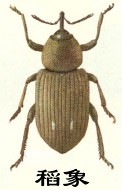Rice weevil, also known as rice weevil, mainly damages rice and can also cause losses in some areas. Adults are dark brown to black, densely covered with grayish-yellow to yellowish-brown hairs. The beak is slender and slightly curved downward. There are many small engraved spots on the pronotum, and there are vertical stripes formed by yellow hairs on both sides. There is a gray-white spot near the end of the elytra. Mature larvae are white, fat, curved and wrinkled, and have no legs.

There is one generation per year in the suburbs of Shanghai. Adults overwinter in field edges, weeds or fallen leaves at the edge of fields, or larvae overwinter in rice piles below the soil surface. Adults appear in April and May, and some larvae of the same year pupate and emerge in late July and early August. It has phototaxis and suspended animation. Able to swim. They hide among the rice bushes and on the backs of leaves during the day and become active at dusk. The eggs are laid about an inch above the water surface at the base of the rice stem. After hatching, the larvae burrow into the soil along the rice stems and feed on rice fibrous roots. There can be dozens of larvae in a cluster of rice roots. The leaf tips of the injured rice turn yellow, and the grains may even be empty or unable to ear. Adult insects eat the stems and leaves of seedlings, and there are rows of bite holes after the damaged inner leaves are pulled out.
animal tags:
We created this article in conjunction with AI technology, then made sure it was fact-checked and edited by a Animals Top editor.